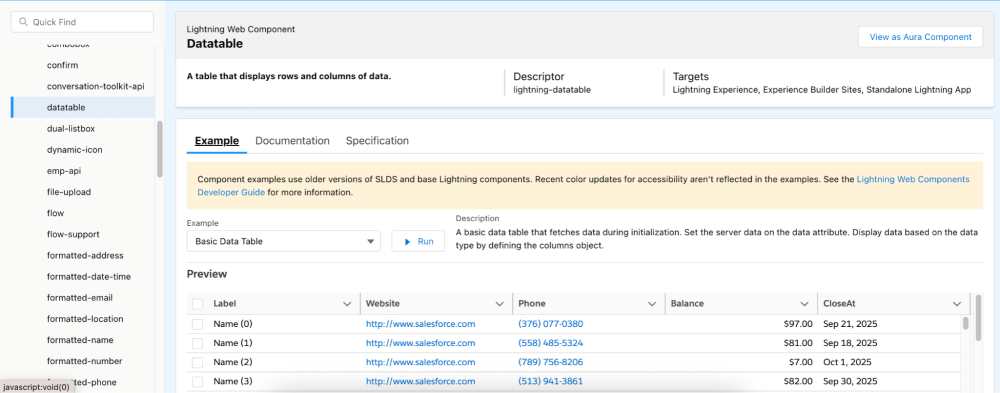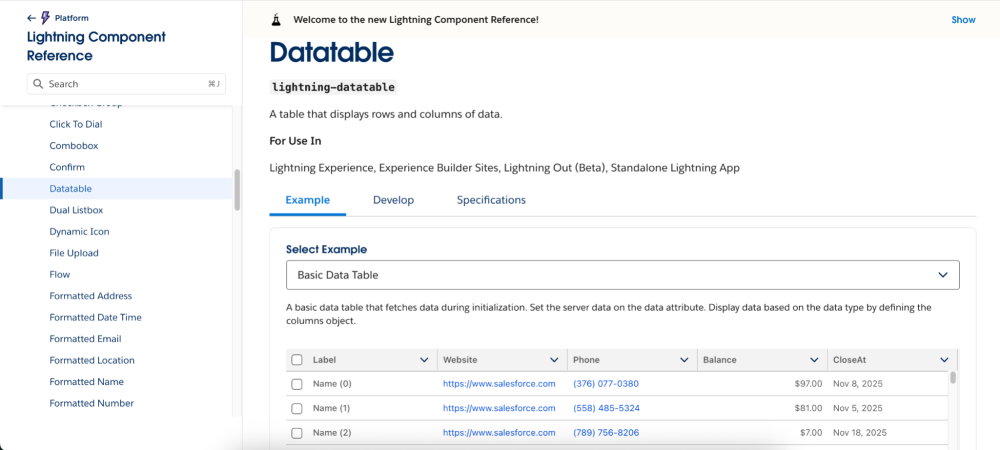From the hallways of Dreamforce to countless conversations at TDX, our developer community wanted us to make it easier to find and use trusted, up-to-date documentation for Lightning Web Components (LWCs). For us, the Salesforce Content Experience (CX) Team, that was a problem we had to solve. Our key aim has always been to help developers get their jobs done quickly, efficiently, and with joy.
In this blog post, we’ll introduce you to our new Lightning Component Reference and explain what developers can expect with the new documentation experience.
The problems: Stuck in the past experience
Our previous Lightning Component Reference, while serving its purpose in its time, presented several significant hurdles that made the development journey difficult. Here are a few problems:
- Agents are here: Our previous Lightning Component Reference documentation wasn’t optimized for broader use cases, such as Agentforce grounding, limiting its utility across our internal tools.
- Technical limitations: Our old site’s LWC examples could not be updated due to the technical limitations of its Aura-based runtime. Adding to the disconnect, styling was frozen on Salesforce Lightning Design System 1, not the modern Salesforce Lightning Design System 2 that developers use today.
- Limited interactivity and visuals: Developers needed working interactive content and visual content. We couldn’t add images in the content to bridge the gap.
- Slow content updates: Keeping documentation current is vital, but the old site’s publishing frequency needed improvement. The delay contributed to documentation quickly falling out of sync with the code.

Our goal was to get the Lightning Component Reference moved and maintained in place, where developers can continue to get their job done in the most trusted fashion.
The solution: A new, enhanced Lightning Component Reference
We are thrilled to announce the launch of our new Lightning Component Reference — a complete, consistent documentation hub designed to empower developers. This new experience is the culmination of our efforts, addressing developer feedback directly and providing them with a superior development resource. This is developers’ new source of trusted content.

Here’s what developers can expect.
- Future-ready content and infrastructure: The content can now be used for Agentforce grounding, expanding its utility beyond just direct developer reference. Plus, we now have the necessary infrastructure to evolve this into a more unified experience for developers and agents.
- Always current and relevant examples: Our new experience features LWC examples that use the current release’s components in a Lightning Web Runtime environment, ensuring that they always exhibit the latest behavior. These examples now correctly show the Salesforce Lightning Design System (SLDS) 2 styling, aligning with modern development practices. Plus, developers can view code examples in light or dark mode. Lastly, we will also be updating examples to demo features that we previously couldn’t with the 2021 components.
- Enhanced discoverability and navigation: We’ve overhauled the navigation to be more intuitive. Developers will benefit from smoother navigation with multiple nesting levels, support for relative links inside pages, and right-side navigation within pages.
- Rich, visual, and interactive content: The new experience now supports images, allowing us to add screenshots, icons, and other visuals to supplement descriptions that were previously text-only. While live-editing of LWC examples isn’t available at launch (and we’re exploring future enhancements here), the examples are running live for immediate reference.
- Rapid and regular updates: To make sure developers always have the latest information, our content can be updated twice per week. This faster update cycle uses the same efficient process as many other dev docs, allowing us to keep pace with new releases and changes. This is supported by a dedicated team available for regular updates.
- Ability to add feedback: Developers now have a way to provide direct feedback on the content via our ubiquitous feedback widget. This opens a direct stream of feedback between the developers and our content team. Ultimately, it helps us in delivering trusted content on a going basis.
What’s next?
One big thing is that the new Component Reference allows for expansion. Yes, today it’s the Lightning Component Reference, but we know that Lightning components are not the only components you may use when building with Salesforce. The new Component Reference is ready-made to include other components, all in one place.
Beyond that, the new Component Reference has also been created to be expandable to include designer-specific information. We’d love to have everything you need to work with components — from design to coding to accessibility — again, all in one place.
We know that you will have thoughts and feedback, and we know that they, too, will shape our roadmap to come. Give it a try and share what you would like to see using the feedback widget at the bottom of each page as we continue to develop and enhance the experience. Thank you for being on this journey with us!
About the author
Prabhav Gupta is a passionate and a creative Product Manager on the Salesforce Content Experience Technologies team, focused on the Salesforce Developer experience on developer.salesforce.com, and content authoring experience for Salesforce content writers. His role also includes making content accessible to large language models (LLMs) and introducing AI into the content development lifecycle. Follow him on LinkedIn.